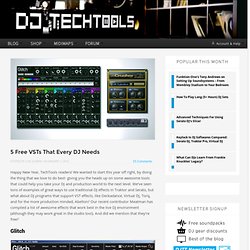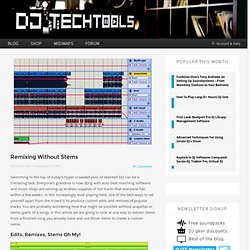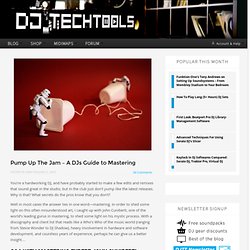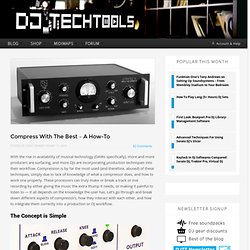

Copyright Concerns For Digital DJs. The world of intellectual property law is quite relevant to musicians, especially DJs and producers that sample other people’s material in performance and composition.

In this article, we provide some general tips for navigating this confusing, potentially treacherous landscape, so read on as we explain the basics behind laws that apply when remixing in your bedroom or playing a mashup routine live. Please be aware that this article is written from the perspective of United States law. The spirit of most other national copyright laws is similar that of the U.S, but there are often important differences. The Basics of Copyright A copyright is an exclusive right, granted by the government, to the author of a particular work. There are two “sides” to music copyrights: a master side and a publishing side. “Infringement” is the legal term for violating someone else’s copyright. Ableton Live Tips: Launch Properties and Follow Actions. DJing in Ableton: How To Warp Tracks with Drifting Tempo. In the first part of our series on how to get started DJing in Ableton Live, we took a look at the possibilities opened up by Live for DJs and learned how to warp an electronic dance track with a steady tempo.

But not every track you’ll want to work into your sets will be as simple as that – what happens when you have a live drummer or a track with serious tempo changes? Here, we look into warping more “difficult” songs with a non-constant tempo. As we’ve noted in the past, most current club tracks produced on modern DAWs, whether house, techno, dubstep, electro or hip-hop, are based on tightly quantized drum patterns. How To Start DJing In Ableton (Part 1) For the past several years, we’ve seen Ableton Live establish itself as a popular and powerful DJ tool, with many top DJs routinely using the software in clubs and stages around the world. While the switch to Live may be daunting for those accustomed to traditional DJ paradigms, the advanced performance capabilities offered can be very worthwhile. 5 Free VSTs That Every DJ Needs. Happy New Year, TechTools readers!

We wanted to start this year off right, by doing the thing that we love to do best- giving you the heads up on some awesome tools that could help you take your DJ and production world to the next level. We’ve seen tons of examples of great ways to use traditional DJ effects in Traktor and Serato, but what about DJ programs that support VST effects, like Deckadance, Virtual DJ, Torq, and for the more production minded, Abelton?
Remixing Without Stems. Swimming to the top of today’s hyper-crowded pool of talented Djs can be a menacing task.

Everyone’s grandma is now djing with auto beat matching software and music blogs are serving up endless supplies of hot tracks that everyone has within a few weeks. In this increasingly level playing field, one of the best ways to set yourself apart from the crowd is to produce custom edits and remixes of popular tracks. Make It loud! DJ’s guide to Mastering Pt 2. You’ve just put together a killer re-mix and spent weeks making everything perfect but its still not bumping like the big club bangers.

Don’t worry- You need professional quality mastering and we are here to try and help. Last month we brought you Part I of our DJ mastering guide, Pump up the Jam, which discussed the concept of mastering with industry experts. This month, we will take you through the process detailing what to look for in each step along the road to mastering perfection. Finally, as if that was not enough, read on for a chance to win 2 of the top mastering plug-ins out there. A free copy of The Glue and T-RackS 3 mastering plug-ins! Before you start. Pump Up The Jam – A DJs Guide to Mastering.
You’re a hardworking DJ, and have probably started to make a few edits and remixes that sound great in the studio, but in the club just don’t pump like the latest releases.

Why is that? What secrets do the pros know that you don’t? Well in most cases the answer lies in one word—mastering. Compress With The Best – A How-To. With the rise in availability of musical technology (DAWs specifically), more and more producers are surfacing, and more DJs are incorporating production techniques into their workflow.

Compression is by far the most used (and therefore, abused) of these techniques, simply due to lack of knowledge of what a compressor does, and how to work one properly. These processors can truly make or break a track or live recording by either giving the music the extra thump it needs, or making it painful to listen to — it all depends on the knowledge the user has. Let’s go through and break down different aspects of compressors, how they interact with each other, and how to integrate them correctly into a production or DJ workflow.
The Concept is Simple A set amount of signal (threshold) passing through the compressor has its dynamic range (how loud or soft the signal is) lowered by a set amount (ratio), at a certain speed (attack, release, knee). First, let’s define some terms you will come across: